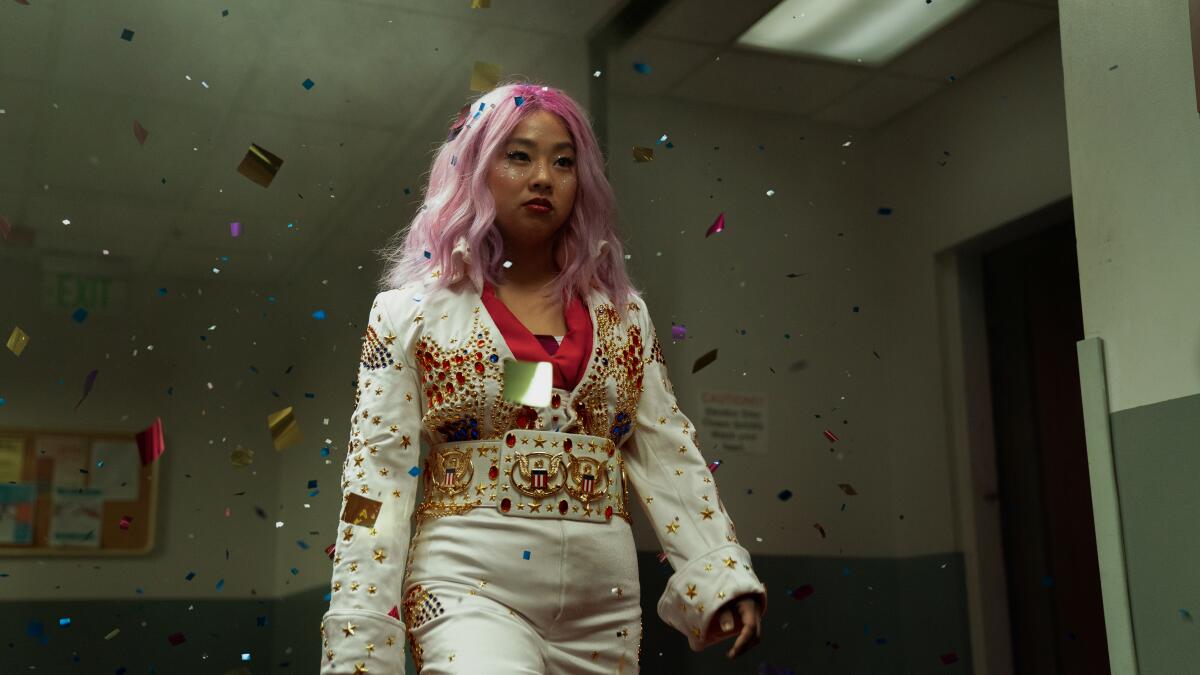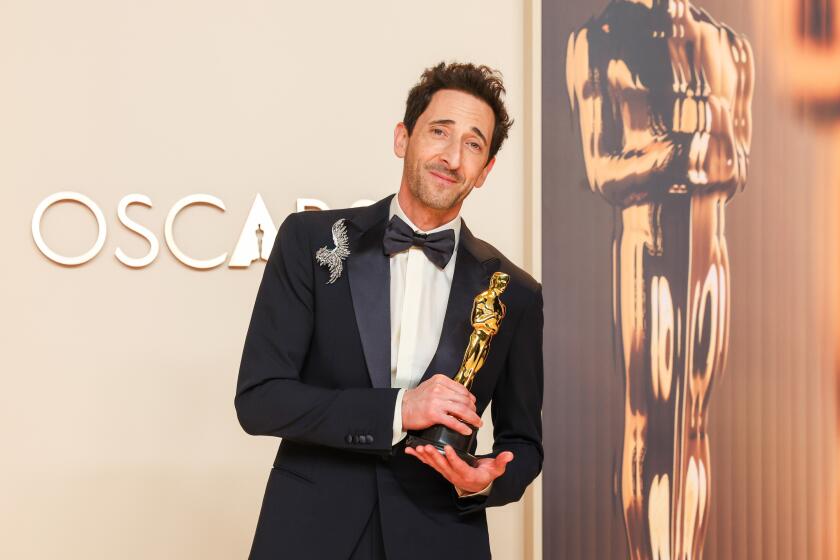It takes a village of small moments to create the emotions of ‘Everything Everywhere’

- Share via
“Everything Everywhere All at Once” editor Paul Rogers tells The Envelope that the most important thing he wanted was to have audiences “care about all these characters.” Judging by the film’s 11 Oscar nominations, including one for Rogers, it seems as though the film’s viewers cared about them very much.
Directed by Daniel Kwan and Daniel Scheinert, known as Daniels, the film is an emotionally complex family drama wrapped inside a kick-ass sci-fi epic. At its core, Evelyn Wang (Michelle Yeoh), a mother and Laundromat owner, finds herself up against her daughter, Joy (Stephanie Hsu) in more ways than she could imagine.
The opening shot introduces us to the Wang family singing karaoke. The camera pushes in on a mirror to suggest that things are not exactly as they seem. Then crack. The music distorts and we’re now in the present day, with Evelyn under a mound of receipts as she tries to prepare for a tax audit with her husband, Waymond (Ke Huy Quan), both speaking Mandarin.
What follows is a dance of family dynamics. We see Evelyn as the matriarch but also the unbearable weight she carries as a mother. We witness Waymond’s unwavering efforts to bring happiness to any situation, googly eyes included. Joy displays the disappointment in her mother, who stops her from coming out to her grandfather (James Hong). Rogers says the opening sequence is what makes the rest of the film work. “A lot of it is due to the beautiful writing Dan and Daniel did in the script,” he says. “We talked a lot about making sure you had a moment with each of these characters. Not just to understand their relationship with each other but also the relationship they have with themselves.”
The camera choreography, as well as how Rogers cut the lively sequence, echoes the epic action scenes that take place later on. Subtle insert shots, such as when Evelyn stops an incoming stool with her foot, teases the spirit of what’s to come. And that is a bizarre, mind-melding adventure complete with hot dog fingers, butt-plug fights, a “Raccaccoonie” chef and an unflinching, multiverse jumping villain in Jobu Topaki (Hsu), who wants nothing more than to see everything crumble.

A key ingredient for Rogers in figuring out the edit was to “let go the way Evelyn does in the film.” Doing so allowed him to understand how densely Daniels explored the family relationships. With the film being edited during lockdown, the themes and emotions of the movie paralleled what the filmmakers were experiencing in the real world. “I had this intense fear of the unknown that Evelyn holds in her. This incredible cynicism that Joy holds in her. And I also had this desire to live in the present and bring joy and happiness into the moment the way Waymond does,” Rogers says. “All of that was coupled with feelings of loneliness and the feelings of connection that permeate the film.”
The emotional magnetism of each character runs deep including in its villain. In a scene where Jobu confronts Evelyn in a hallway, she asks if she can open up Evelyn’s mind. The two interlock fingers, and soon they are transported into a white room with a bagel floating in the air. Jobu somberly says she put everything on this bagel, which led her to the truth that nothing matters. “If nothing matters, then all the pain and guilt you feel for making nothing of your life, it goes away.”
“That scene was important. It’s the moment where Jobu has lost hope and meaning,” Rogers notes. “It might be easy to see Jobu as a one-dimensional evil villain, but seeing that look on her face while she’s describing why she made the everything bagel is such an important link to the two characters Joy and Jobu. That went a long way in making Jobu a more interesting villain to watch. The best villains are kind of heartbreaking and you understand where they are coming from.”
Another layer Rogers managed in the edit was the use of foreshadowing, particularly how Waymond “fights” with kindness and optimism instead of with physical punches and kicks. The editor subtly hints at the conflict saving tactic early on when the family goes to the tax audit with a by-the-book IRS agent, Deirdre (Jamie Lee Curtis). The scene has Evelyn leaping back and forth between universes as she tries to figure out what’s going on. She becomes a distraction during the audit, which has Deirdre threatening them with fines until Waymond jumps in. “That’s kind of his first fight scene in the way he fights,” says Rogers. “He is using kindness and brings cookies, and by the time Evelyn finally comes back, he has won the fight and Deirdre gives them until 6 p.m. to come back.” Waymond’s style turns out to be far more effective in defeating the enemies Evelyn has to fight.
In retrospect, Rogers says, “what I always dreamed of while working on this film was that it would help people not feel as alone and engender the empathy that we should have for the people around us, especially for our family, parents and grandparents.”
More to Read
From the Oscars to the Emmys.
Get the Envelope newsletter for exclusive awards season coverage, behind-the-scenes stories from the Envelope podcast and columnist Glenn Whipp’s must-read analysis.
You may occasionally receive promotional content from the Los Angeles Times.






